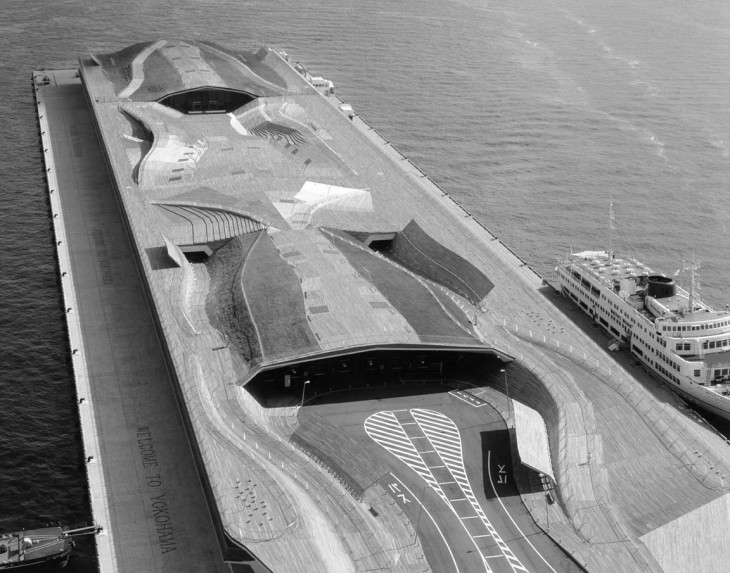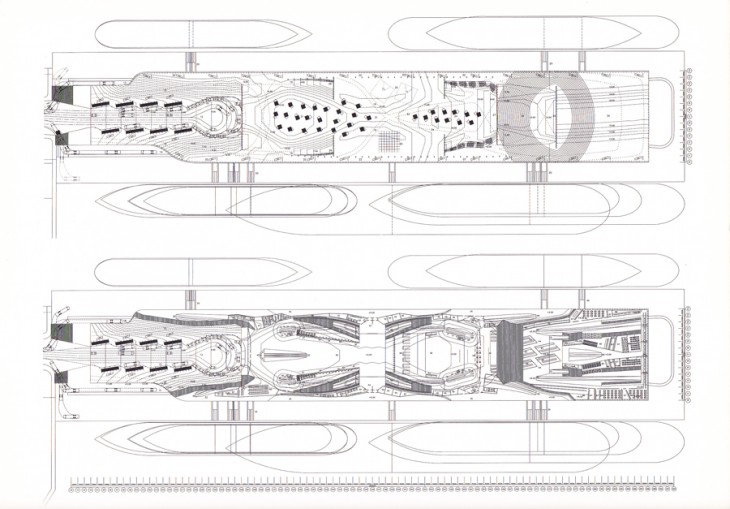Part – 1
YOKOHAMA TERMINAL

yokohama terminal – view
The Yokohama International Passenger Terminal was the product of inventive architectural methodology and socially conscious thinking. Its radical, hyper-technological design explored new frontiers of architectural form and simultaneously provoked a powerful discourse on the social responsibility of large-scale projects to enrich shared urban spaces. This structure is well integrated and successfully done by using parametric techniques and public private concepts for large-scale developments. Proposal for the project start by declaring the site as an open public space and proposes to have the roof of the building as an open plaza, continuous with the surface of Yamashita Park as well as Akaranega Park. The project is then generated from a circulation diagram that aspires to eliminate the linear structure characteristic of piers, and the directionality of the circulation. The concept was to create the open spaces on the top and to align the waterfront with the building roof to create fluidity in the extension of the urban fabric, which is basically a hybridization between a shed – a more or less undetermined container – and a ground, thus inventing a unique architectural/urban typology, one that would go on to influence a generation of architects. The hybridization of infrastructure, landscape and architecture, the integration of computer-aided design into the practice of architecture, and maybe the exploration of a global practice were tested through this project into a real building.

1st & 2nd floor Plans
The two criteria: It is unique (there never has been a pier like it), and it is architecturally an experiment: an investigation in a new, more fluent way of organizing flows – no longer ‘everything put in its place’ but a freer language that can make the familiar exciting again.
Part – 2
Deleuze and the Genesis of Form by Manuel DeLanda
Manuel DeLanda explores Gilles Deleuze’s work “The Genesis of Form”. The main concept developed in his study is Finding Form. In other words, the genesis of form and structure seems to always involve resources that go beyond the capabilities of the material substratum of these forms and structures. In some cases, these resources are explicitly transcendental, eternal essences defining forms which are imposed on infertile materials. The clearest example of this theory of form is, of course, religious Creationism, in which form begins as an idea in God’s mind, and is then imposed by a command on an obedient and docile matter.
As Gilles Deleuze has shown in his work on Spinoza, Deleuze discovers another possibility: that the resources involved in the genesis of form are not transcendental but immanent to matter itself. Deleuze quotes a lot of examples about actualization , like the process of embryo genesis involves a spaio- temporal dynamics governed again by many topological points.He has to say that a form or structure is created and generated by the flow of energy.And all of these forms have a Nuoumena and a phenomena, Nuoumena is what we perceive and phenomena is what we see.For example , the story of an elephant and the four blind men , how all the four blind men, when they touch the elephant have a different sense of perspective that is the nuoumena ,but in reality its an elephant which is the phenomena.But deep down there the nuoumena is again closely connected to the phenomena ,which creates a lot of complication to clearly understand the fundamental ,Because then it starts to involve the differences of intensity , temperature , pressure , tension , etc ,Hence , examples from thermodynamics are explained which conclude that the physics branch is highly obsessed with the final equilibrium forms .but this is again found that the role of single virtual essence can be tracked or grasped during the process of morphogeneses which is before the final form of actualization , before the difference disappears.
After a lot of other examples explained by deleuze , such as the sediment and the ingenious rocks , the market with different buyers and sellers , and many more in detail ,Deleuze concludes that these homogeneous components together and actualization of a virtual process which connects to the heterogeneous elements through interlock and intercalation.these are perfectly real which has nothing to do with virtual reality.The creation is not only related to computer simulations , but also painters, musicians , filmmakers , etc all have real energetic flow which creates or forms the piece of work .
As a conclusion, Deleuze’s work constitutes a true challenge to language-obsessed postmodernism, a neo-materialism which promises to enrich the conceptual reservoirs of both science and art and that one day could lead to a complete re-conceptualization of our history as well as of our alternatives for the future. There is a virtual reality process of everything that exist. These virtual processes are, according to Deleuze, perfectly real, a real virtuality which has nothing to do with what we call virtual reality.